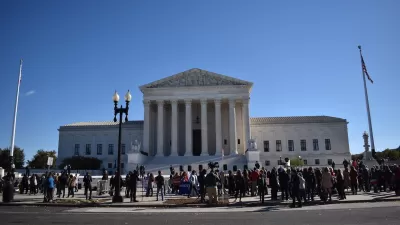The Supreme Court might decide on the constitutionality of inclusionary zoning. Local land use regulations and affordable housing policies in cities and communities all over the country hang in the balance.

Kriston Capps reports on the background and details of a court case expected to appear before the Supreme Court that amounts to whether inclusionary zoning is an unconstitutional government taking of private property.
The court case was born in Marin County, where two property owners, Dartmond and Esther Cherk, were forced to either include affordable housing or pay an in-lieu fee when trying to develop a residential parcel into two single-family-zoned lots.
Capps explains the stakes of a possible Supreme Court hearing for Dartmond Cherk, et al. v. Marin County, California.
The Marin County case may test the constitutionality of inclusionary zoning, a tool that local jurisdictions rely on to expand the supply of affordable housing, especially in tight housing markets. The court has expressed an interest in the case, which the justices may wind up using as a wedge to reshape property rights. It’s possible the inclusionary zoning ordinances—and local regulations more broadly construed—will not stand under the court’s scrutiny.
Capps explains the status of the case relative to the Supreme Court's interest in deciding the matter. "Housing advocates and industry associations are filing briefs on both sides of the case," according to Capps, and "the court asked Marin County for its response, which attorneys must file by October 7."
The Supreme Court's position on whether inclusionary zoning amounts to an unconstitutional taking could also have implications for land use regulations that have environmental outcomes in mind, according to Capps.
FULL STORY: Will the Supreme Court Strike Down Inclusionary Zoning?

Planetizen Federal Action Tracker
A weekly monitor of how Trump’s orders and actions are impacting planners and planning in America.

Congressman Proposes Bill to Rename DC Metro “Trump Train”
The Make Autorail Great Again Act would withhold federal funding to the system until the Washington Metropolitan Area Transit Authority (WMATA), rebrands as the Washington Metropolitan Authority for Greater Access (WMAGA).

DARTSpace Platform Streamlines Dallas TOD Application Process
The Dallas transit agency hopes a shorter permitting timeline will boost transit-oriented development around rail stations.

San Francisco's School District Spent $105M To Build Affordable Housing for Teachers — And That's Just the Beginning
SFUSD joins a growing list of school districts using their land holdings to address housing affordability challenges faced by their own employees.

Car-Centric LA Suburb Looks to a Train-Oriented Future
City leaders in Rancho Cucamonga, the future western terminus of the Brightline West rail line to Las Vegas, want to reimagine the city as a transit-oriented, pedestrian-friendly community.

New Alaska Bitcoin Mine Would Burn as Much Energy as the State’s Largest Coal Plant
Fueled by “stranded” natural gas, the startup hopes to become the largest in the US, and to make Alaska an industry center.
Urban Design for Planners 1: Software Tools
This six-course series explores essential urban design concepts using open source software and equips planners with the tools they need to participate fully in the urban design process.
Planning for Universal Design
Learn the tools for implementing Universal Design in planning regulations.
Municipality of Princeton
Roanoke Valley-Alleghany Regional Commission
City of Mt Shasta
City of Camden Redevelopment Agency
City of Astoria
Transportation Research & Education Center (TREC) at Portland State University
US High Speed Rail Association
City of Camden Redevelopment Agency
Municipality of Princeton (NJ)





























